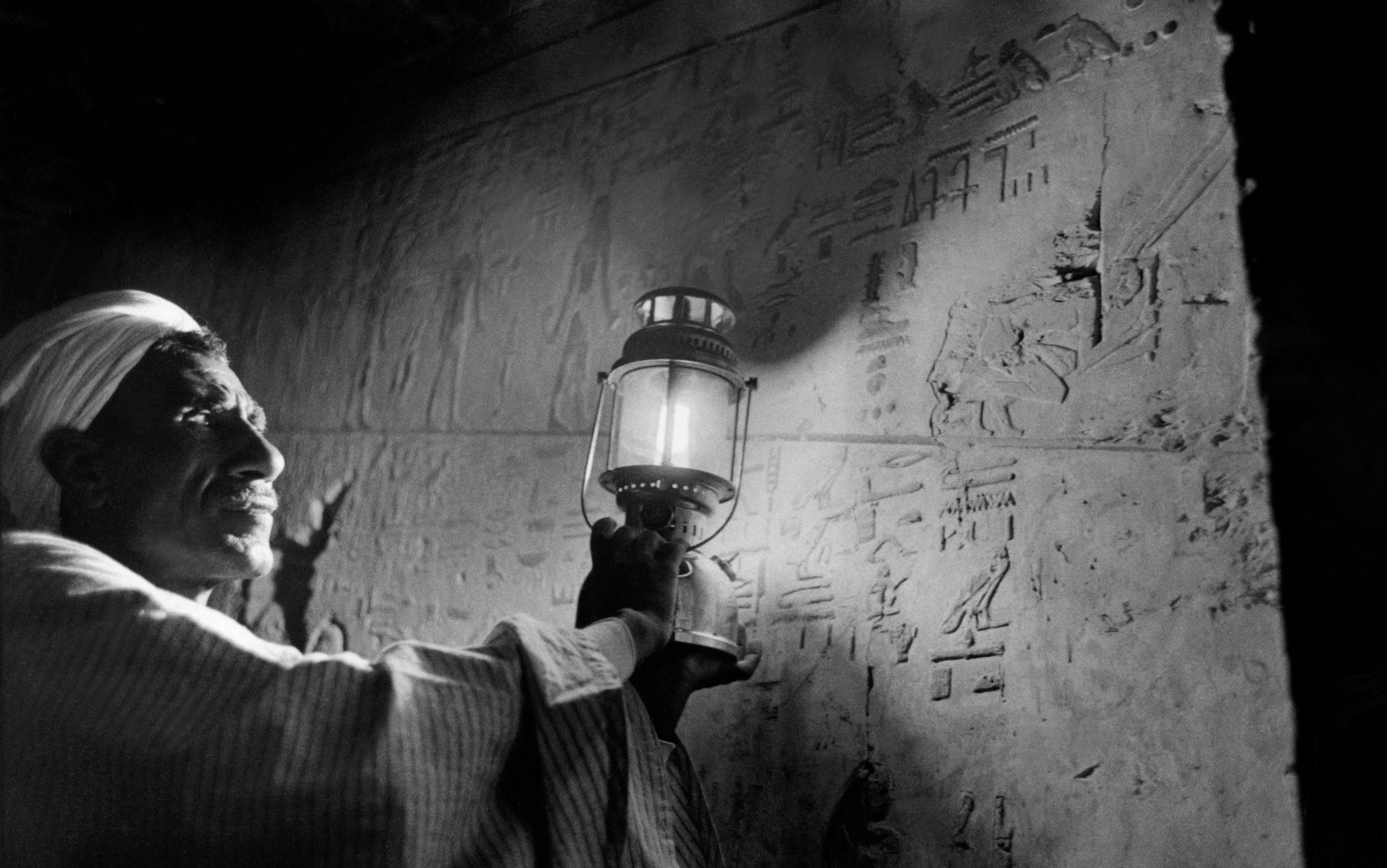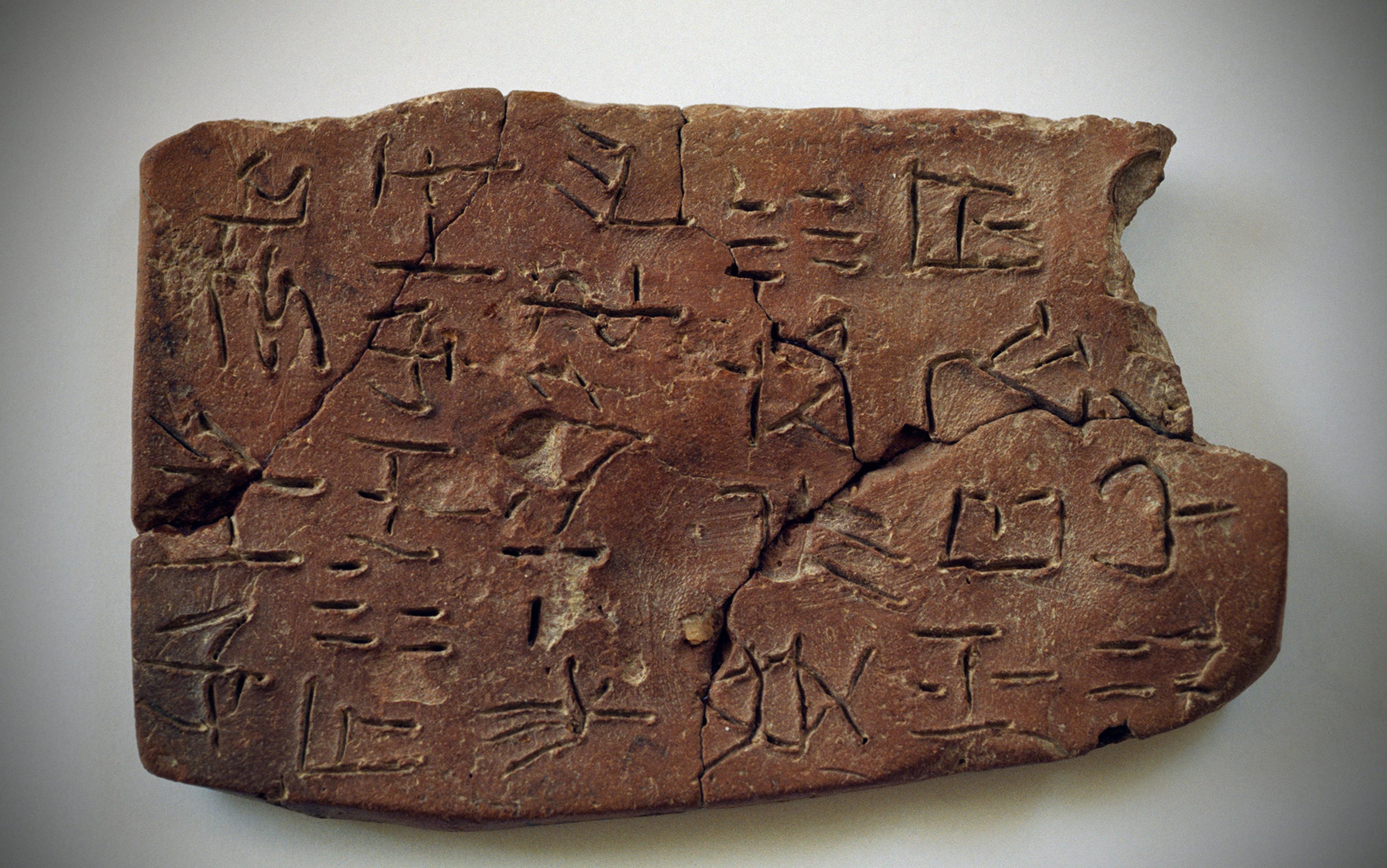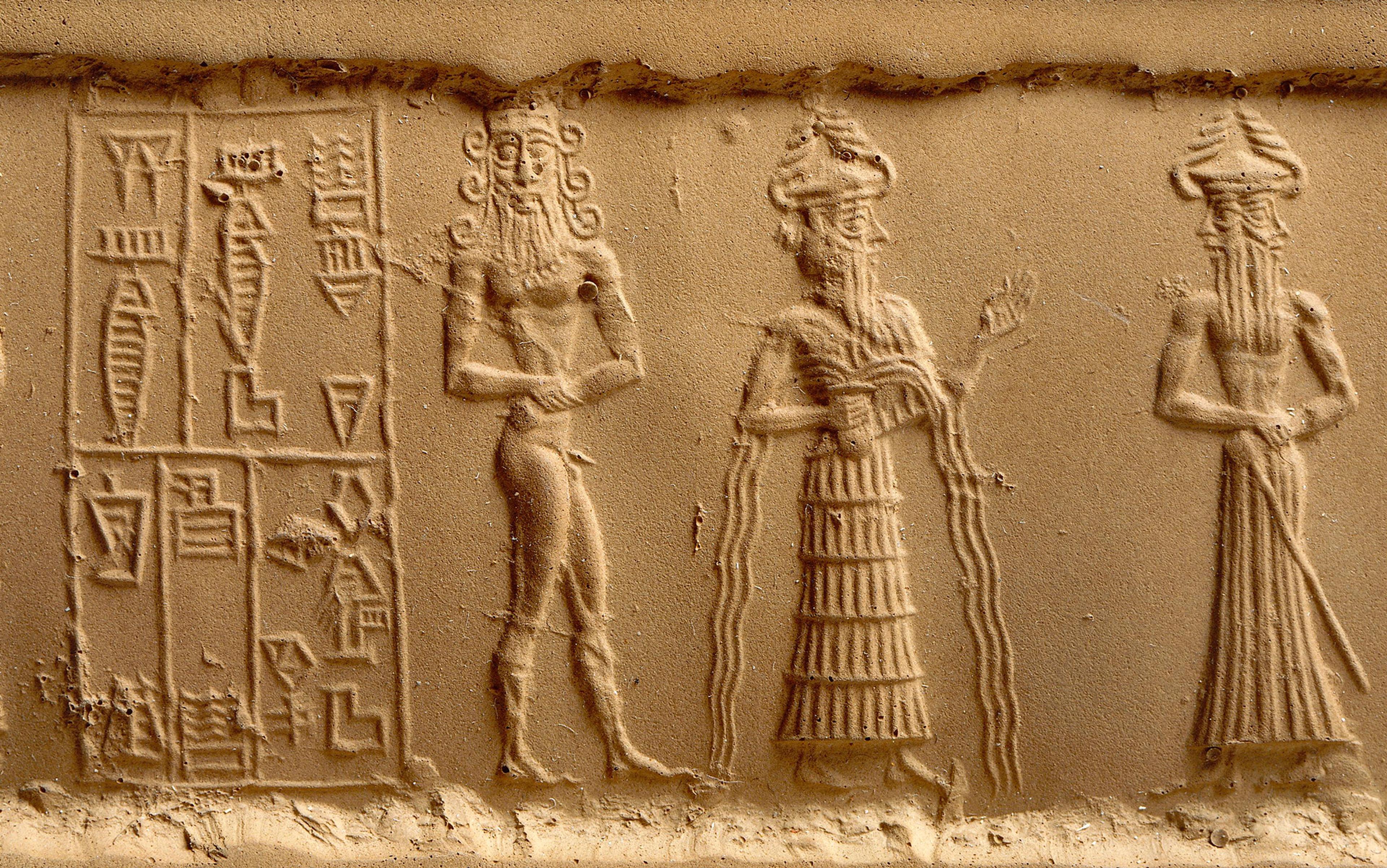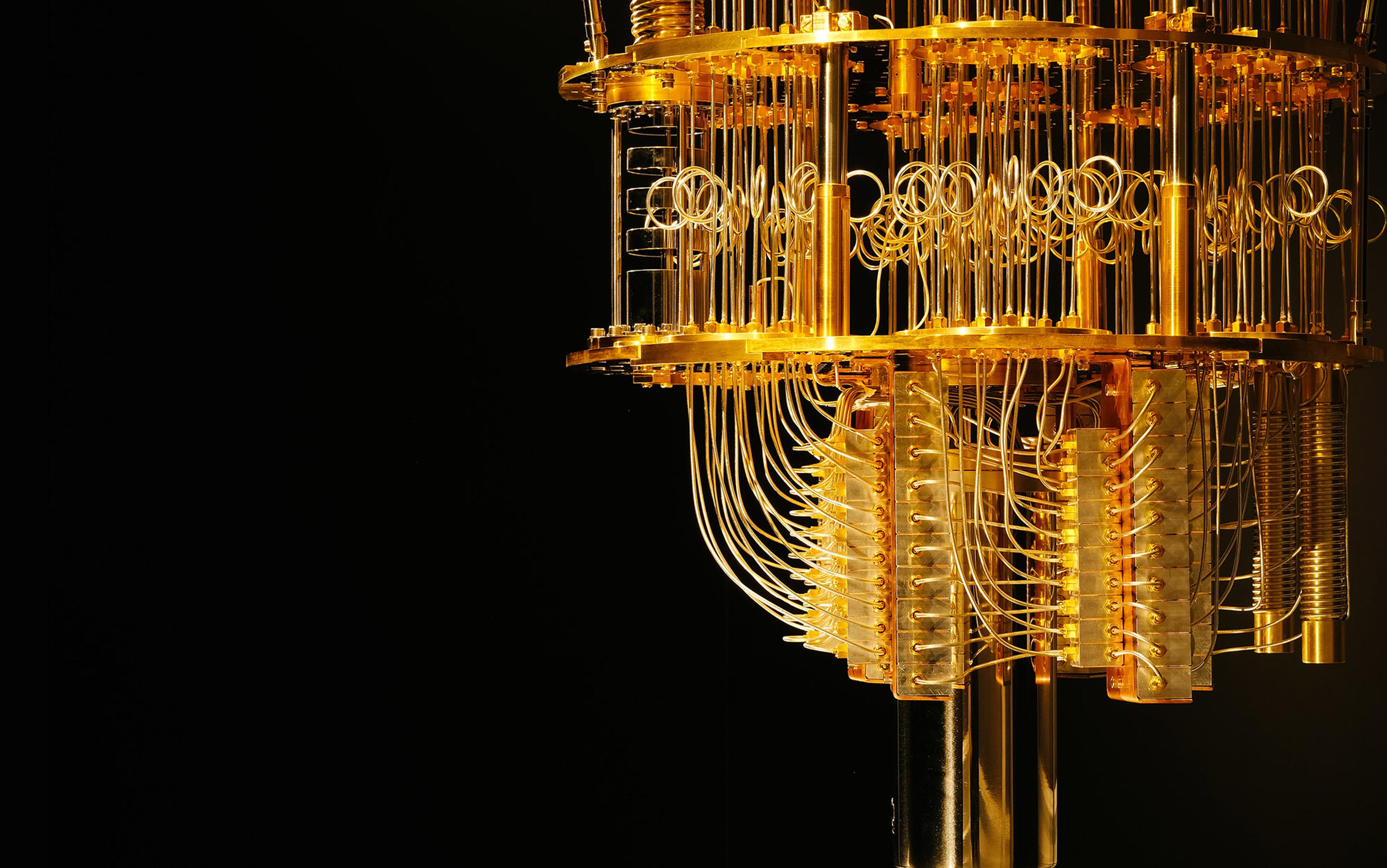I am a glyph-breaker. I confess. Guilty as charged. A glyph-breaker who didn’t break anything, and that is quite paradoxical, because, to be a true glyph-breaker, you should have deciphered an undeciphered script, like Jean-François Champollion (the founder of Egyptology, who decoded the Ancient Egyptian hieroglyphs), Henry Rawlinson (who gave us the key to cuneiform) or Michael Ventris (who deciphered Linear B). Well, I didn’t. But I tried. I still try, in a way. And, in our times of devolution, that probably qualifies a guy to be called a glyph-breaker. The age of the great decipherments is, in all likelihood, over. What remains: a considerable amount of poorly documented, extremely elusive writing systems and ‘inscribed relics’, like Linear A, the Indus Valley Script, Rongorongo, and the Singapore Stone. Puzzles. Possibly unsolvable. Headache-generators. Nasty stuff.
Despite this, a glyph-breaker cannot be scared. A glyph-breaker doesn’t surrender. Theoretically. I started a quarter of a century ago, in 1999, when I was at the University of Pisa in Italy, with Linear A, the undeciphered writing system from Bronze Age Crete, ‘hiding’ the so-called (unknown) Minoan language. I probably studied everything there was to study on that script, I reproduced many of the previous (and unsuccessful) decipherment attempts, and I tried to decipher the writing system by myself. I failed. Obviously. I am not Ventris, the genius who deciphered the ‘grammatological daughter’ of Linear A, which already transcribed Ancient Greek in its oldest known form. And Linear A is not Linear B. I didn’t completely give up, nonetheless. I started, with my research teams – originally at Nanyang Technological University (NTU) in Singapore, and now at Xi’an Jiaotong-Liverpool University in Suzhou (Jiangsu) in China – to develop cryptanalytic and computational approaches and tools to better understand Linear A. I am analysing it in a comprehensive and unbiased fashion, trying to provide my team and scholars from around the world with insights that, one day, could perhaps lead to the decipherment of that writing system.
I don’t believe much in computational approaches. But I believe in cryptanalysis – breaking secret codes to reveal hidden information. And, in today’s world, cryptanalysis is computational by definition. Technology cannot replace human ingenuity and cannot lead automatically to the decipherment of an undeciphered script. But it can save a lot of work and pain to scholars. My team developed a Python program that feeds a computer we called ‘The Machine’ that can develop, in a reasonable amount of time, an exhaustive cryptanalytic brute force attack on the Linear A signs.
In 2016, I also started to work on the enigmatic and fragmentary text of the Singapore Stone, a unique and undeciphered epigraph whose signs are found nowhere else in the world. No way to decipher it, unless we get very, very lucky; there isn’t enough text and no bilingual parallels were ever found. My work, therefore, due also to my bittersweet experience with Linear A, was aimed, since the beginning, at a better understanding of the fragmentary epigraph on the Stone in itself. With my team at NTU, we developed a device we called ‘Read-y Grammarian’ – a sort of prediction machine capable, once fully functional, of tentatively guessing the missing parts or signs of the Stone’s inscription, ideally providing us with projections of its possible complete text. This doesn’t lead to any direct decipherment, but allows scholars studying the document to achieve a better understanding of its writing system, of plausible words, and of the possible structure of presumable sentences. The more we know about an undeciphered text, the closer we are to its possible decipherment.
Over time, therefore, I became a sort of tool-developer for deciphering languages, targeting scripts that are considered very unlikely (Linear A) or impossible (Singapore Stone) to be deciphered. I’m not sure that this fully qualifies me to be a glyph-breaker, but that’s it. It is what it is. Point is that I never wanted to be a glyph-breaker for the sake of being a glyph-breaker, not even when I started studying Linear A, 25 years ago. I was just insatiably curious, and I wanted to know more and understand better. Above all, I was pursuing the dream of all historical linguists and glyph-breakers: I wanted to return their own voices to peoples from the past by being able to read the written documents they’d left behind. That is what scholars who study the history and the evolution of writing systems do and dream – that is their path.
That path is mercilessly lonely. Full of bumps and disappointments, generally characterised by bitter self-assessment and self-reflection, with a lot of regrets. A glyph-breaker’s life can become very dark (or bizarre – it depends on how they take it), especially in academia.
Language deciphering isn’t a recognised academic discipline, nor systematically taught or practised
I was relatively lucky. I survived. I even got a rare research grant on Linear A. Of course, I had my fair share of unsettling situations: for example, at the inauguration of an academic year at a previous university, one department coordinator (who knew nothing about language deciphering) introduced me to our freshmen and all the other faculty as ‘the guy who works on weird stuff that even he himself doesn’t understand’. But that comes with the job, I suppose. Conversely, other scholars way more knowledgeable than me were crushed, professionally and morally. Humiliated, isolated, excluded. That is a shame, abominably unfair.
Indeed, leaving aside my meagre experiences and uninteresting stories, it’s not an exaggeration to say that the intellectual life of a glyph-breaker is hopelessly lonely. Despite the fact that the decipherment of ancient writing systems is considered a fascinating endeavour and that people are episodically attracted by news involving archaeological discoveries and the interpretation of ancient scripts, what today can be called language deciphering isn’t properly a recognised academic discipline, doesn’t belong to any specific field (a bit of linguistics, a bit of philology, a bit of cryptology, a bit of grammatology, etc), and isn’t systematically taught or practised in universities.
If somebody deciphered a previously undeciphered writing system for real today, many individuals and institutions would jump on the bandwagon of that glyph-breaker. One or more universities would claim that the new ‘genius’ is affiliated with them (perhaps, the scholar studied there 20 years before the discovery or was a neglected part-time lecturer whose contract wasn’t renewed) and top-tier academic journals would enter a fierce competition to publish the findings. The press would fill pages and pages for 48 hours, only to shunt the story to oblivion on day three.
This is a dystopian scenario because, in recent years, it’s increasingly rare that undeciphered writing systems are fully deciphered at all. Many enigmatic scripts, like the Ancient Egyptian hieroglyphs, cuneiform and Linear B, mentioned above, have fortunately already been deciphered, while more challenging systems (many lacking a consistent corpus, historical context or significant parallels) may never be deciphered.
In fact, the full and incontrovertible decipherment of an ancient writing system in 2025 would be not only an amazing feat, but also something people are no longer used to. Think of what happens whenever someone claims to have deciphered the ineffable (and still-undeciphered) Voynich Manuscript, a book containing bizarre illustrations of plants, presumably from Central Europe, dated to about the 15th century CE. Excitement, chaos, mayhem, scepticism and disappointment ensue every time.
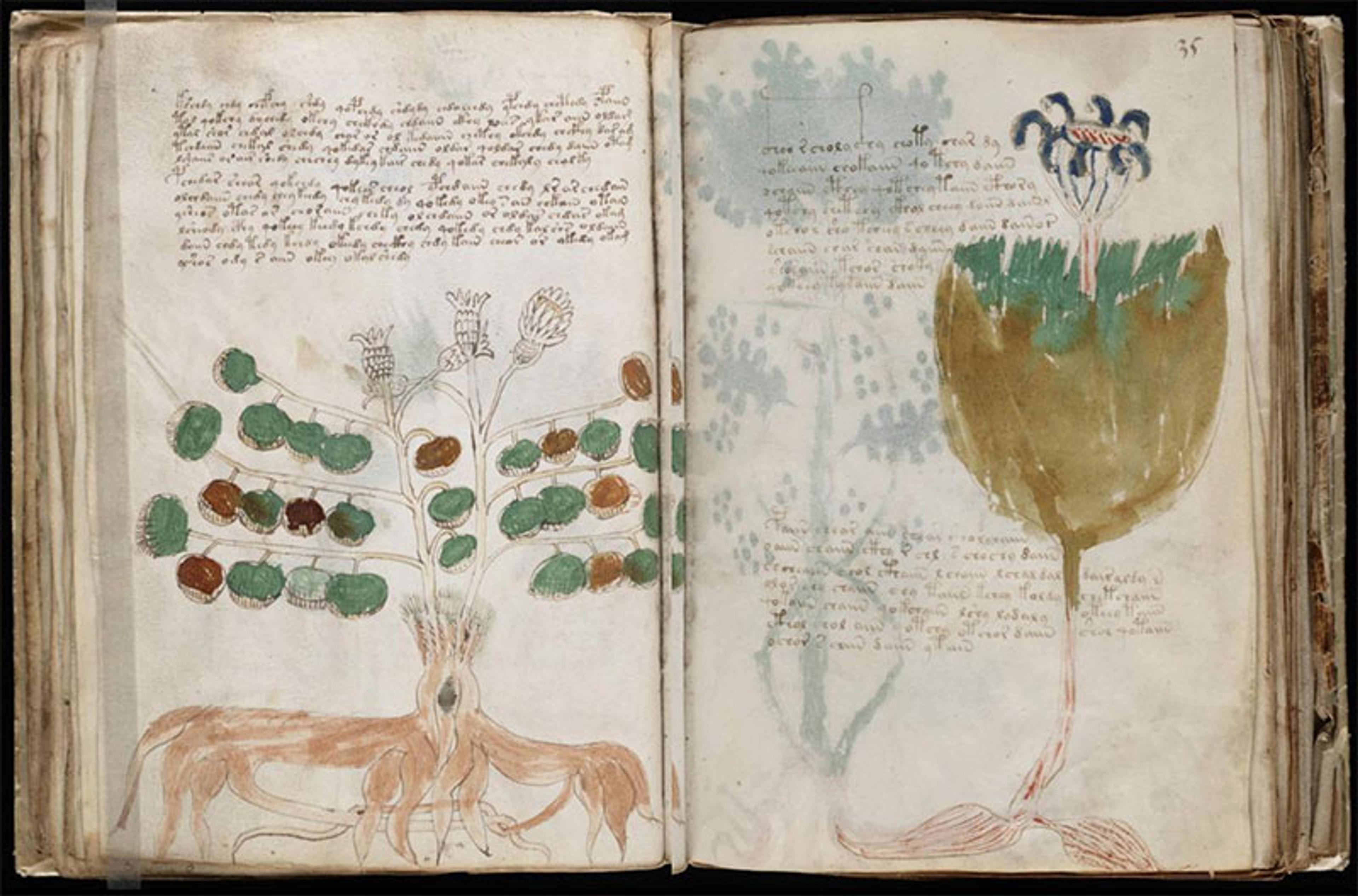
Pages from the mysterious Voynich Manuscript. Courtesy the Beinecke Rare Book and Manuscript Library
In addition to straightforward amateurs and history or language buffs (who sometimes succeed, due to their unwavering commitment), there are those who chase the glyphs for all the wrong reasons: unspeakable mystery, undisclosed ‘wisdom’, incredible revelations, the cure for all the ‘plagues’ of the world, straight out of Indiana Jones. Then there is an actual glyph-breaker, a scholar who deals with linguistics, history, cryptology, computer science – anything related to the task of deciphering an undeciphered script. That glyph-breaker works silently, for years, on the writing system that attracted their attention one day far away in their past, studying, experimenting, reproducing, gathering a mountain of negative results, starting from scratch again, and again, and again.
To decipher the script you’re working on is the only promise you cannot make
That glyph-breaker will presumably fail. Not because of their ‘quality’ as a scholar. Not because their methods are flawed or ‘not good enough’. No. It is just the law of large numbers. An undeciphered writing system is, by definition, impossible to decipher by normal means, even when the highest skills, professionalism and deepest knowledge are involved and applied. Often, all depends on a lucky match, the right intuition on a phonetic value for a symbol, or the correct interpretation of a segment or cluster of signs. When that doesn’t happen, the glyph-breaker will quietly consume all their intellectual resources, perseverance, patience, ideas and hope, and slowly give up. Nobody (I hope) will mock their years of research or the knowledge they developed and shared with the academic world. However, the script stays undeciphered and a candle goes out.
Instead of pursuing this futile quest, the ‘easy’ way to go in academia today is to focus on simple(r) things – do what everyone can do, follow the steps of the ones who came before you, do some little, simplistic research that can be considered ‘just good enough’ to be ‘scientific’. Publish a lot, publish fast, no matter what, no matter how, in top-tier journals where papers are retracted more and more often because of misconduct and ethical issues, while the rest are read by almost no one, not even within the academic community.
This is the exact opposite of what a glyph-breaker should do. To achieve the daunting, almost impossible task of deciphering an undeciphered writing system, a scholar should fully devote themselves to a lifetime of collaborative study, analysis, interpretation, failed attempts and exhausting rethinking. That doesn’t pay off, though. If you are that glyph-breaker, the so-called senior management will start to ask you what is it that you’re doing, where are your publications, where is the research output that you’re providing your university with. The most generous managers will promise to support you – on one simple, easily achievable condition: that you decipher the script you’re working on, which is the only promise you cannot make. As for most of your colleagues, focused on discovering what is already disarmingly self-evident and publishing papers that add almost nothing to the knowledge of a field, they’ll think that you’re the funny or boring (that depends on you) guy in the office next door who deals with things that nobody understands and who wastes their time chasing dreams and stuff that nobody cares about. You won’t get many collaborators, you won’t become a chair or dean, you may not even get tenure, and you’ll probably have to migrate somewhere else. If you’re strong, you’ll survive. If you aren’t, you’ll change and you’ll become like the others – or you’ll break.
Language deciphering is a sub-field of linguistics, philology and cryptology (specifically cryptanalysis). It requires a tremendous amount of knowledge, uncommon skills and almost inhuman dedication – in addition to courage and creativity. To get the job done, a glyph-breaker must think in unconventional ways and should never be afraid of failure. All mistakes are painful and discouraging; however, they are indispensable steps towards the final goal.
Once a writing system is finally deciphered, a new world opens before our eyes. Before that, we knew a civilisation that used a script we weren’t able to read only through its material culture, archaeological findings and remains or external historical sources. After we’re able to read the writings of that civilisation, a whole new treasure trove of information is readily available to us. Deciphering languages is, therefore, not only the archaeology of writing, but the only discipline that allows us to discover ancient peoples through their own words, by reading the documents they left behind.
When the French philologist Champollion deciphered the Ancient Egyptian hieroglyphs, in 1822, all of a sudden the Egyptian civilisation was no longer just the evocative, somehow mysterious culture known through its spectacular monuments and historical records from other more or less contemporary peoples (like the Greeks). Not everyone was happy with his work and, because of his ideas, the world of politics didn’t support him. The Ancient Egyptian hieroglyphs had been a majestic and apparently impenetrable puzzle, seen at first as ‘figures’ or pictographic signs. Many scholars before Champollion believed they were ‘semagrams’ (pictorial characters carrying the meaning of what they’re representing) – for instance, the picture of a bird represented, simply, a bird; they had not considered the possibility of phonetic representation, or the sounds composing the actual word for ‘bird’. It was Champollion who showed us that was a mistake. The hieroglyphs were, indeed, in high percentage ‘phonograms’ (symbols with specific phonetic values, like the characters of an alphabet) and, therefore, they should have been read accordingly.
Champollion almost died trying to accomplish the task of his life. The effort was so demanding it led to a dangerous physical consumption. Yet, when he was done, the Egyptian civilisation started to talk directly to us. Its depiction of itself included not just its macro-history (the dynasties, the pharaohs, Alexander the Great, the Romans), but also the daily life of ordinary people and all the secrets that only written texts can unveil.
The slab was an extraordinary discovery that helped researchers analyse the hieroglyphic and demotic scripts
Over time, Ancient Egypt has had several writing systems: the spectacular and pictorial Ancient Egyptian hieroglyphs (c3250 BCE-c400 CE), the simplified hieratic script (c3200 BCE-300 CE), the more ‘cursive’ demotic (c650 BCE-500 CE), and Coptic (200 CE, still used in Coptic liturgy). The Ancient Greek alphabet was also adopted after Alexander the Great conquered Egypt in 332 BCE.
Champollion deciphered the Ancient Egyptian hieroglyphs with help from the Rosetta Stone, a slab inscribed with a bilingual epigraph discovered by Napoleon’s army in 1799, during the campaign in Egypt. The Stone, an upright slab called a stele in archaeology, contains a decree dating back to the year 196 BCE, in the time of king Ptolemy V Epiphanes. What is relevant is not its content, but its format. The stele repeats the same text three times, transcribed through Ancient Egyptian hieroglyphs (top), demotic (centre), and the Ancient Greek alphabet (bottom).
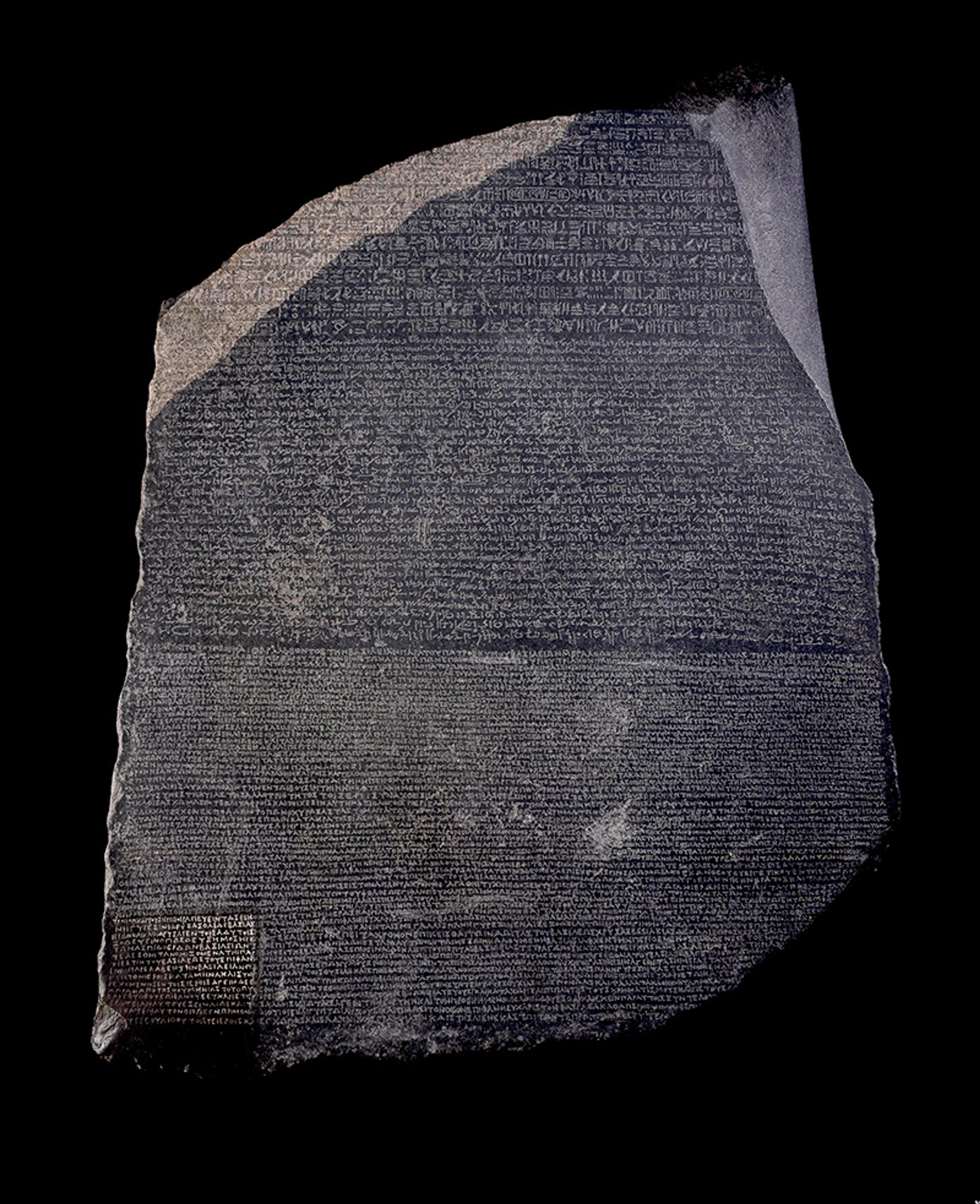
The Rosetta Stone. Courtesy the British Museum, London
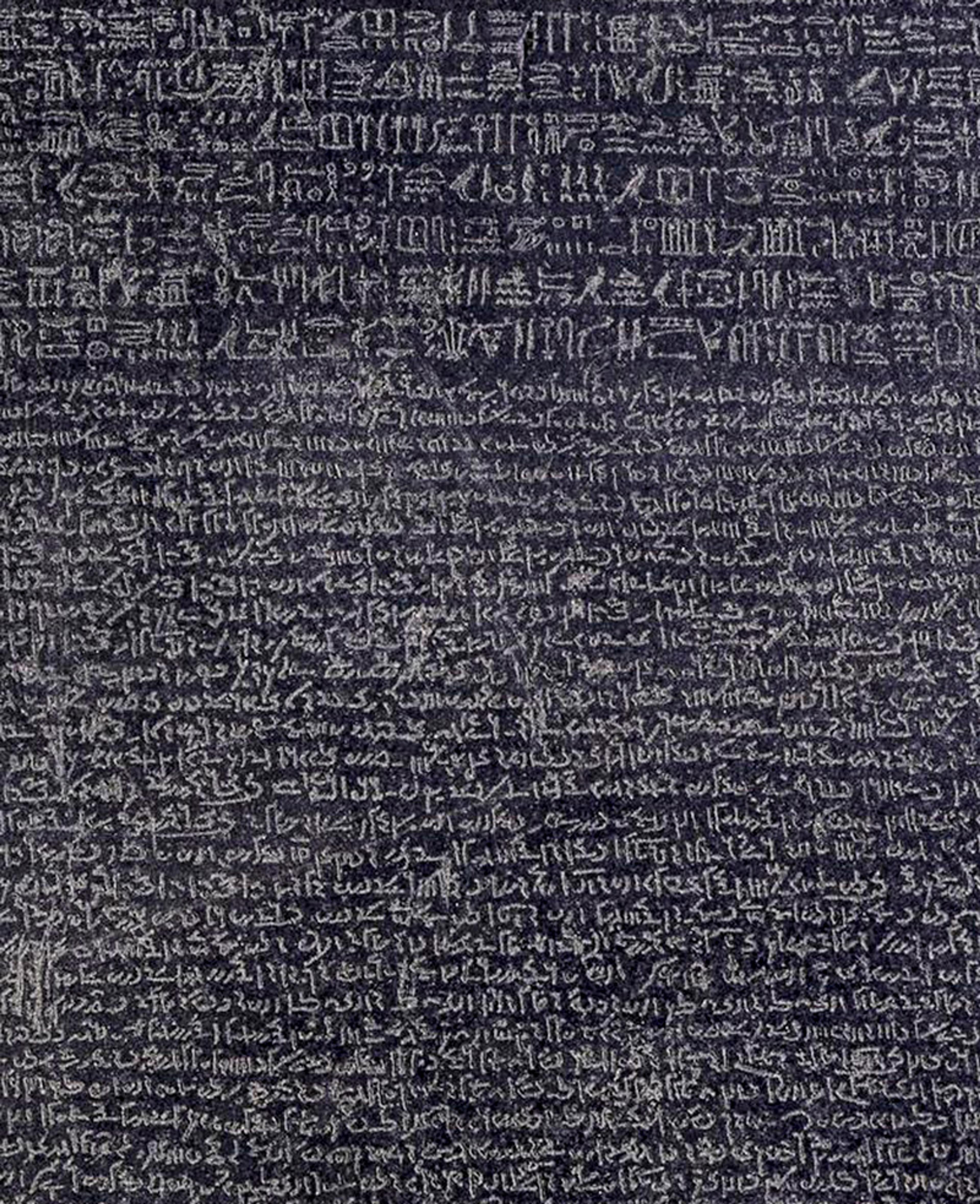
The Rosetta Stone (detail). Courtesy the British Museum
The slab was an extraordinary discovery because its Ancient Greek text helped researchers to analyse the hieroglyphic and demotic scripts. Using the Ancient Greek portion, in 1814 the polymath Thomas Young identified the names of Greek rulers who had governed Egypt, as they appeared in hieroglyphic form.
One key breakthrough was the recognition of the name ‘Ptolmis’ (the Egyptian version of the name of king Ptolemy) in the hieroglyphic section, as well as the realisation that royal names were enclosed in ‘cartouches’ – ovals with a single line at one end. For the first time in history, researchers could phonetically read Egyptian hieroglyphs spelling out the names of Greek kings and queens.
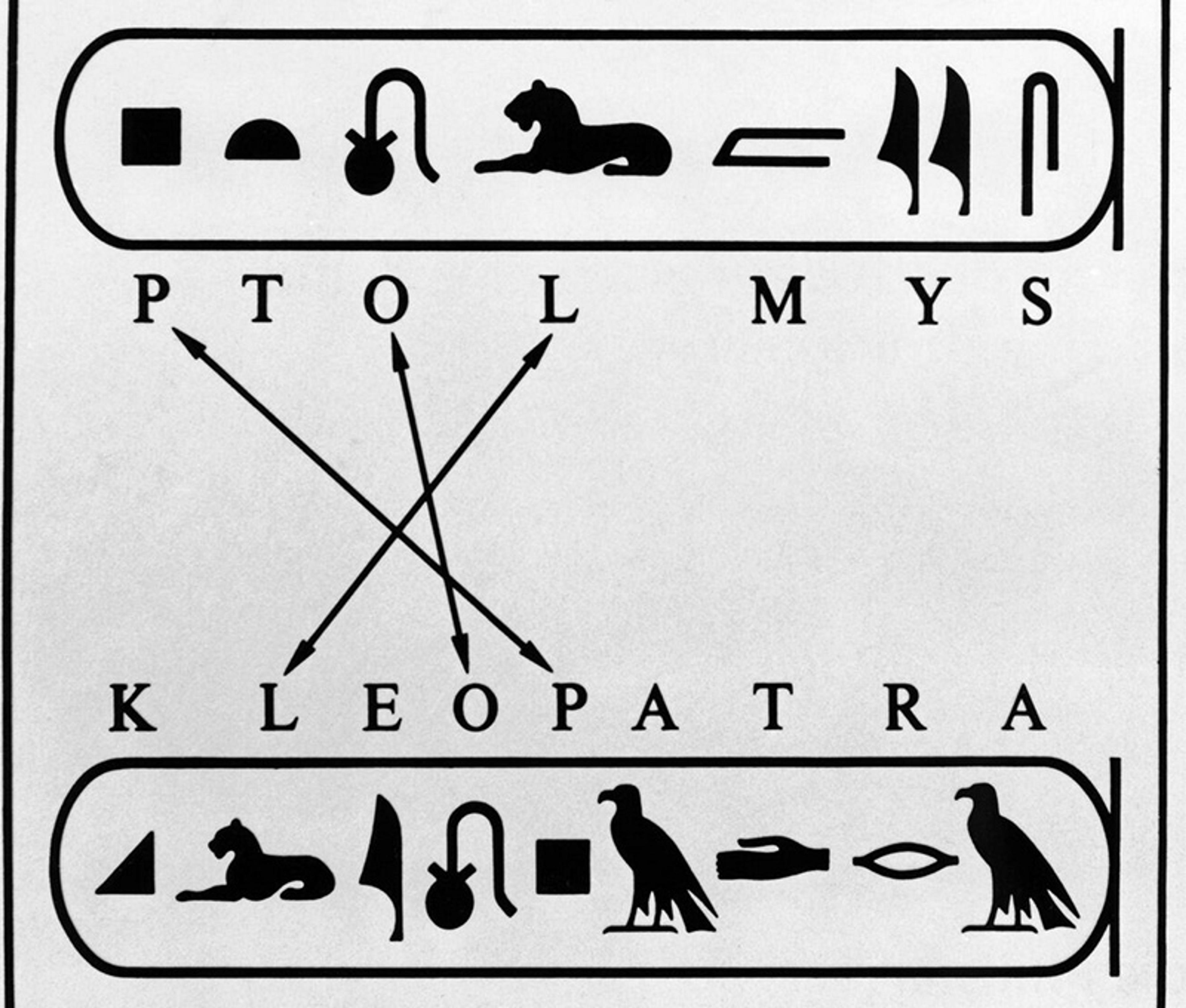
The names of King Ptolemy and Queen Cleopatra in Ancient Egyptian hieroglyphs. Public domain
However, this did not mean the writing system had been fully deciphered. The Greek rulers, descendants of Alexander the Great, were not Egyptian, so it made sense that there were no pictographic symbols directly representing them. At this point, Young stopped his investigation and moved on to other areas of research.
Champollion, who had been fascinated by the hieroglyphs since childhood, took on the challenge. He analysed other Greek names to reconstruct possible phonetic values and, through hieroglyphic inscriptions, developed a comprehensive system of phonograms. Yet, recognising Greek names alone was not enough to unlock the language of the ancient pharaohs.
Champollion’s achievement was a mix of genius, intuition and educated guesses
Determined to find genuinely Egyptian names, he focused on an undeciphered cartouche containing the name of Ramses (Ramesses II). No one had deciphered it before, as it was not a Greek name, so he had to rely entirely on his own knowledge and reasoning. The cartouche contained four symbols. The first resembled a sun disk with a dot in the centre – an eye. In Egyptian mythology, Ra was the sun god, often depicted as an all-seeing eye. Champollion assigned the phonetic value /ra/ to this symbol, as the word ra also meant ‘sun’ in Coptic.
The last two symbols were already known from the Greek names of Egyptian rulers like Ptolemy and represented the /s/ sound. That left only one unknown symbol between them. Champollion knew that the name ‘Ramses’ was well-documented in historical sources, so he hypothesised that the missing symbol represented the /m(e)/ sound. This gave him the sequence: RA – M(E) – S – S, leading to Ram(e)ss = Ramses = Ramesses. With that, he had successfully deciphered the first Egyptian name!
This achievement was a mix of genius, intuition and educated guesses. But it would have meant little without another breakthrough.
Since the word ‘sun’ in Coptic was ra, exactly as in Ancient Egyptian, Champollion realised that Coptic wasn’t just another language, independent of the language ‘hidden behind’ the hieroglyphs – instead, Coptic was a later form of Ancient Egyptian. This insight meant that Ancient Egyptian had never truly died, but had survived through Coptic dialects. Using this understanding, along with the Coptic lexicon and phonetic values from Greek rulers’ names, he triggered a ‘snowball effect’ that allowed him to read the hieroglyphs and uncover the Afro-Asiatic language they concealed: Ancient Egyptian.
Hieratic and then demotic turned out to be simplified (and way more recent, in the case of demotic) versions of the hieroglyphs as well. Over time, it became clear that the four writing systems – hieroglyphs, hieratic, demotic, and Coptic – were transcribing the same language, Ancient Egyptian or, simply, Egyptian.
Champollion’s work represents one of the highest achievements of human ingenuity, made possible by his perseverance, knowledge, genius and determination – and by a series of fortunate circumstances (Champollion had studied Coptic – without that, he would not have been able to proceed). He never gave up, and this immeasurable task cost him his health – he died young, at 41 years of age, in 1832.
After Champollion’s groundbreaking work on Egyptian hieroglyphs, another ancient script awaited its decipherment – Linear B, the writing system of the Mycenaean Greeks. While the hieroglyphs had been used in Egypt for thousands of years, Linear B belonged to an entirely different civilisation and time period, dating back to around 1400-1200 BCE. Unlike the hieroglyphs, which combined logographic elements (symbols representing entire words or concepts) with phonetic signs, Linear B was mostly a syllabic script, meaning its characters represented sounds rather than words or ideas.
Deciphering Linear B required a unique approach. Before her untimely death at the age of 43 in 1950, the American linguist Alice Kober made a critical discovery: Linear B was an inflectional language, meaning that its words changed form (specifically their endings) depending on their grammatical role. She also demonstrated that the script was syllabic.
As he matched phonetic values to their corresponding syllabograms, he began to read Mycenaean Greek
Building on her work, Michael Ventris, a British architect and cryptology amateur, finally cracked the code. Using cryptanalytic techniques likely learned during his time in the Royal Air Force, Ventris developed a system of grids to analyse the symbols systematically. Through a rigorous process of trial and error, he began assigning tentative phonetic values to the syllabograms – written symbols that represented entire syllables. His key breakthrough came when he compared Linear B with the Cypriot syllabary, a later script used for the Arcado-Cypriot dialect of Greek. Recognising a shared syllabogram, NI, he hypothesised values for frequently occurring clusters of signs in different tablets, identifying the recurring A-MI-NI-SO as Amnisos, the port of Knossos.
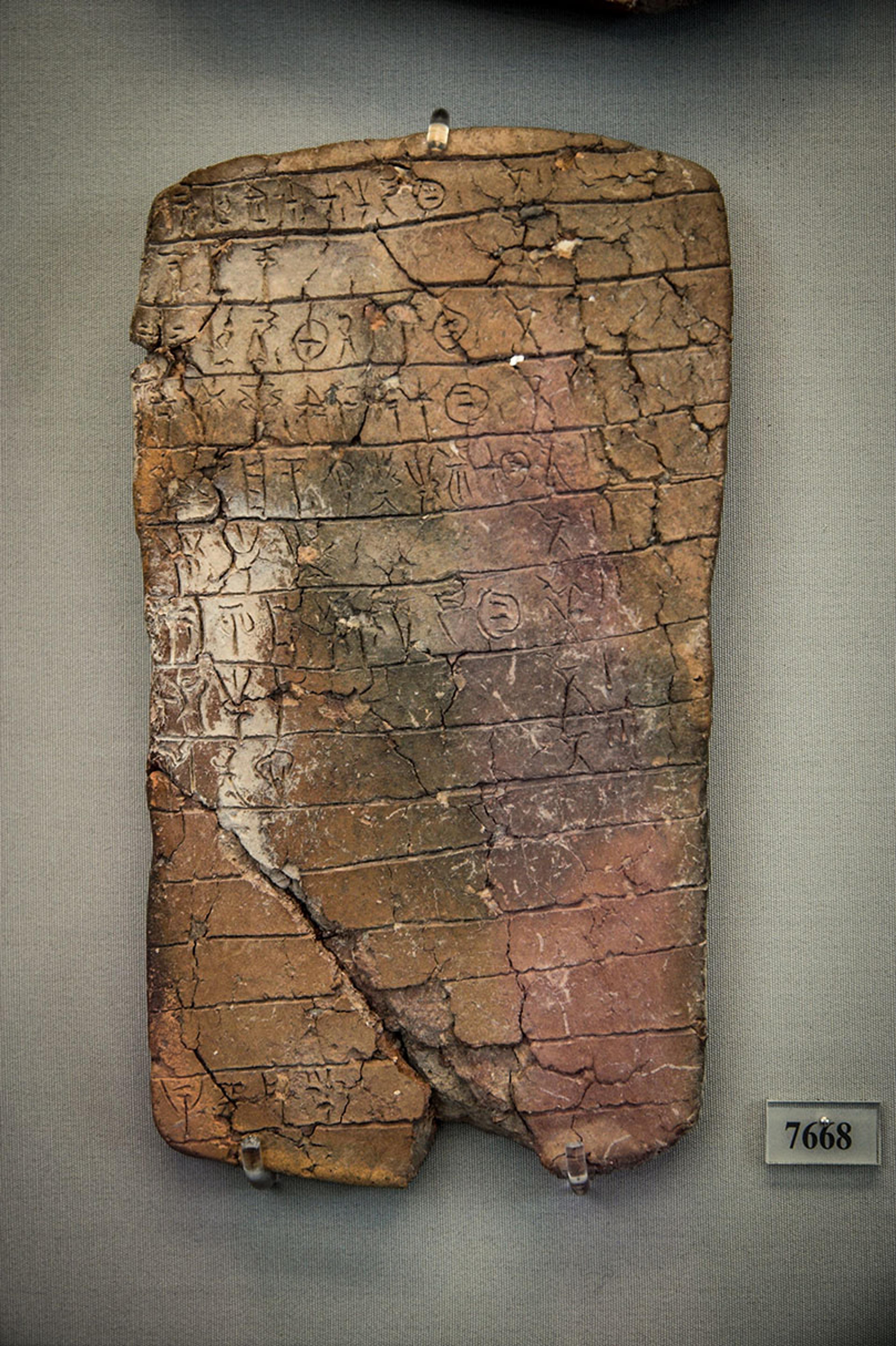
Clay tablet inscribed in Linear B from the Archaeological Museum of Mycenae. Public domain
From there, using a comparative approach, Ventris reconstructed the name Knossos (KO-NO-SO). As he correctly matched phonetic values to their corresponding syllabograms, he began to read Mycenaean Greek, the language concealed within Linear B. This was the earliest known form of Greek, plausibly spoken by the legendary figures of Homer’s epics, predating archaic and classical Greece by centuries.
Ventris’s achievement was extraordinary – not only because he deciphered an ancient script, but because he did so without formal training as a linguist or philologist. His breakthrough unlocked the complexities of Mycenaean society and shed light on the most distant chapters of Greek history, proving that the past still has secrets waiting to be revealed.
Sadly, Ventris died in 1956 at the age of 34, after this stunning work, and the decipherment of Linear B was completed by the English linguist John Chadwick.
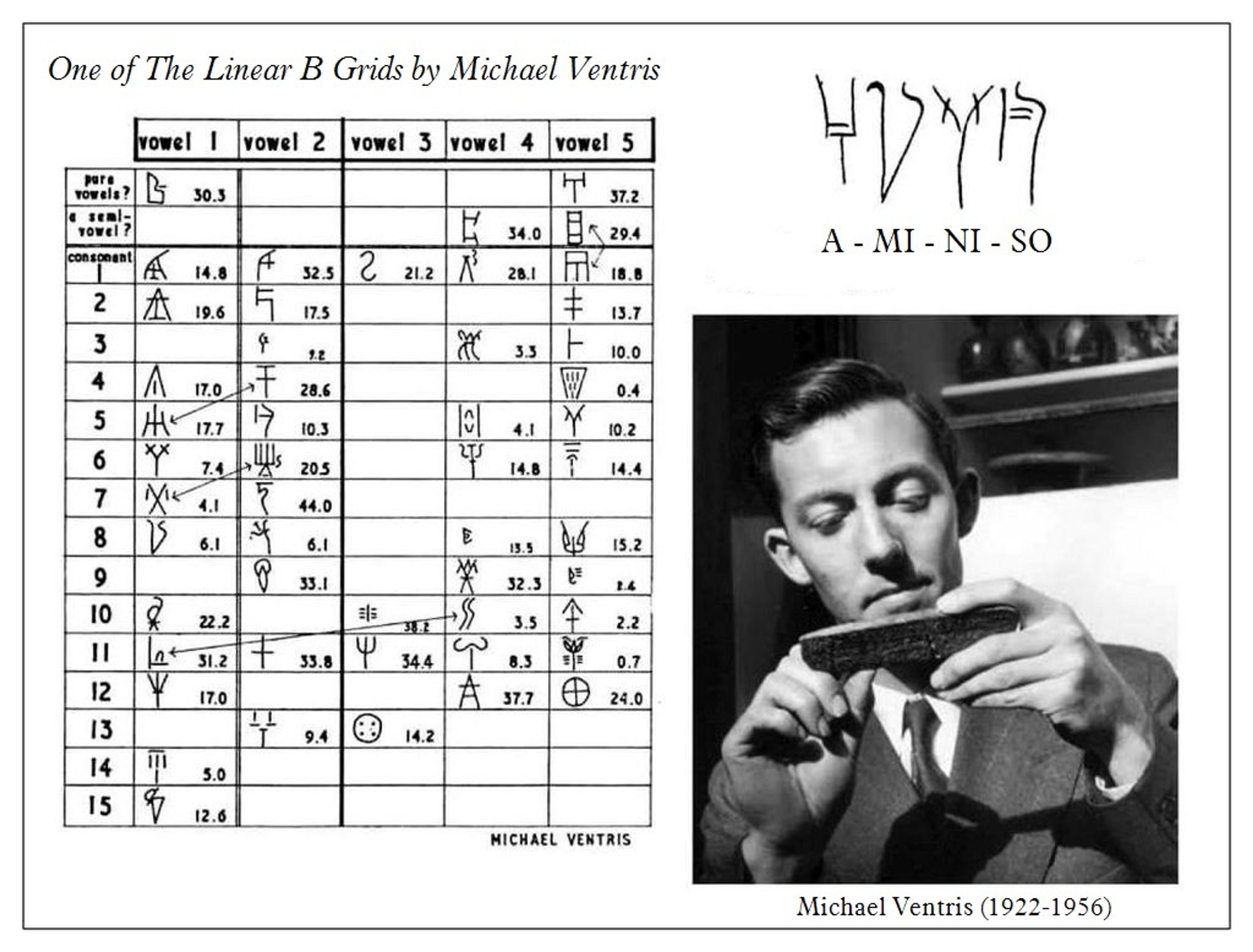
Michael Ventris and the place name Amnisos (A-MI-NI-SO). Public domain
The Ancient Egyptian hieroglyphs and Linear B were, before their decipherments, unintended crypto-systems. Invented to develop written records, their information was lost over time, transforming them into impenetrable sets of unreadable symbols. Moreover, before their decipherments, they were unknown writing systems transcribing unknown languages, therefore fully undecipherable. And yet, Champollion and Ventris deciphered them. With pen and paper. Actually, with their brains and perseverance.
Champollion’s and Ventris’s achievements are luminous milestones in the study of human civilisations and breathtaking monuments to the almost limitless horizons of human ingenuity. In today’s world, especially at the academic level, they look almost impossible to replicate. Many academics tend to specialise in their own niche corner. They no longer master the all-embracing expertise and knowledge of the great scholars from the past. What’s worse, they often don’t aim at achieving that knowledge and are content to move within their little ‘vegetable garden’, without any aspiration to expand it. Most academics don’t want to deal with problems that, possibly, have no solution. They’re not good for publications. They’re not valuable to one’s career. Therefore, rather than broadening our interests and the extent of our operations, we’re closing ourselves in.
Universities should support their people towards the achievement of what is believed to be unattainable
Today, many think that everything can be solved by AI (and quantum computing). We cannot teach anymore without that, we cannot validate our findings, we cannot produce our original ideas, we cannot say two words without having to mention some artificial intelligence’s wonders. AI is definitely a prodigious tool, and it’s not impossible it will provide us with keys to decipher long-undeciphered scripts. That would be ideal, and I would be the first to rejoice if AI was able to complete a full decipherment, but I doubt it will. Champollion and Ventris weren’t able to avail themselves of AI – yet, thanks to their brilliance and ingenuity, they got where AI probably won’t lead us, at the end of the day.
Rather than trying to amass oceans of scientific papers listing self-evident results and futile findings, instead of inserting AI and unnecessary technologies into the most human of activities, like teaching, universities and research institutions should value and support their people (something that, nowadays, happens more and more rarely) and be especially inclusive of the ones among them who are able to think outside the box, to go the extra mile towards the achievement of what is believed to be unattainable or, simply, impossible – like the decipherment of undeciphered writing systems.
There’s no question that challenges remain. Linear A, the Phaistos Disc, the Indus Valley script, the Rongorongo writing system, the Singapore Stone and many other mysteries still await their codebreakers. Their decipherment seems unlikely – especially for scripts with very few surviving texts – but so too did the breakthroughs in Ancient Egyptian hieroglyphs and Linear B.
It will take dedicated and brilliant scholars to push these frontiers forward. But, for that to happen, universities must recognise the value of their work and provide them with the resources, collaboration and stability needed to continue. Without this support, we risk not only the end of decipherment, but also a profound loss of human curiosity and discovery – an intellectual silence that no AI, nor the short-sightedness of those in power, should be allowed to impose.

